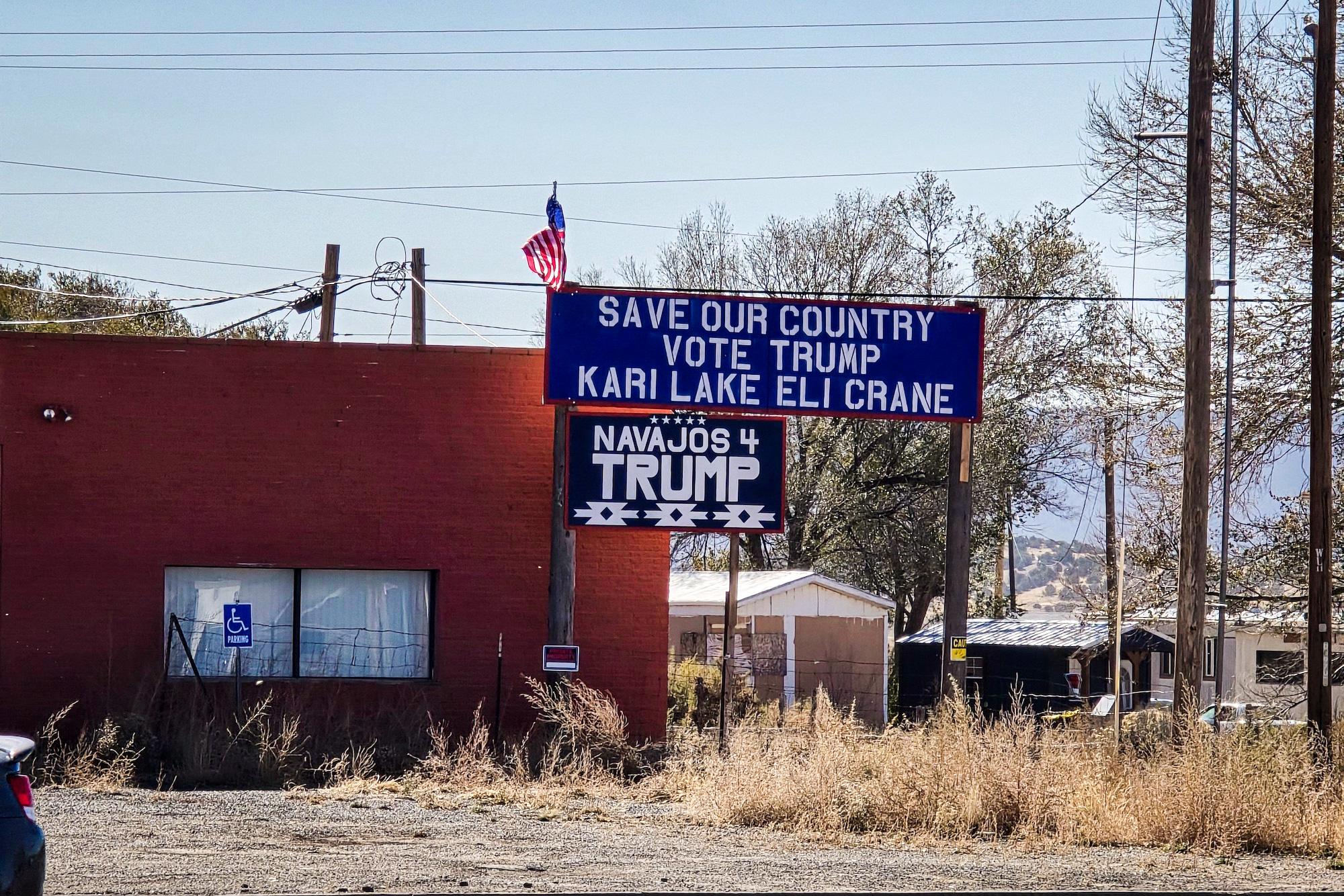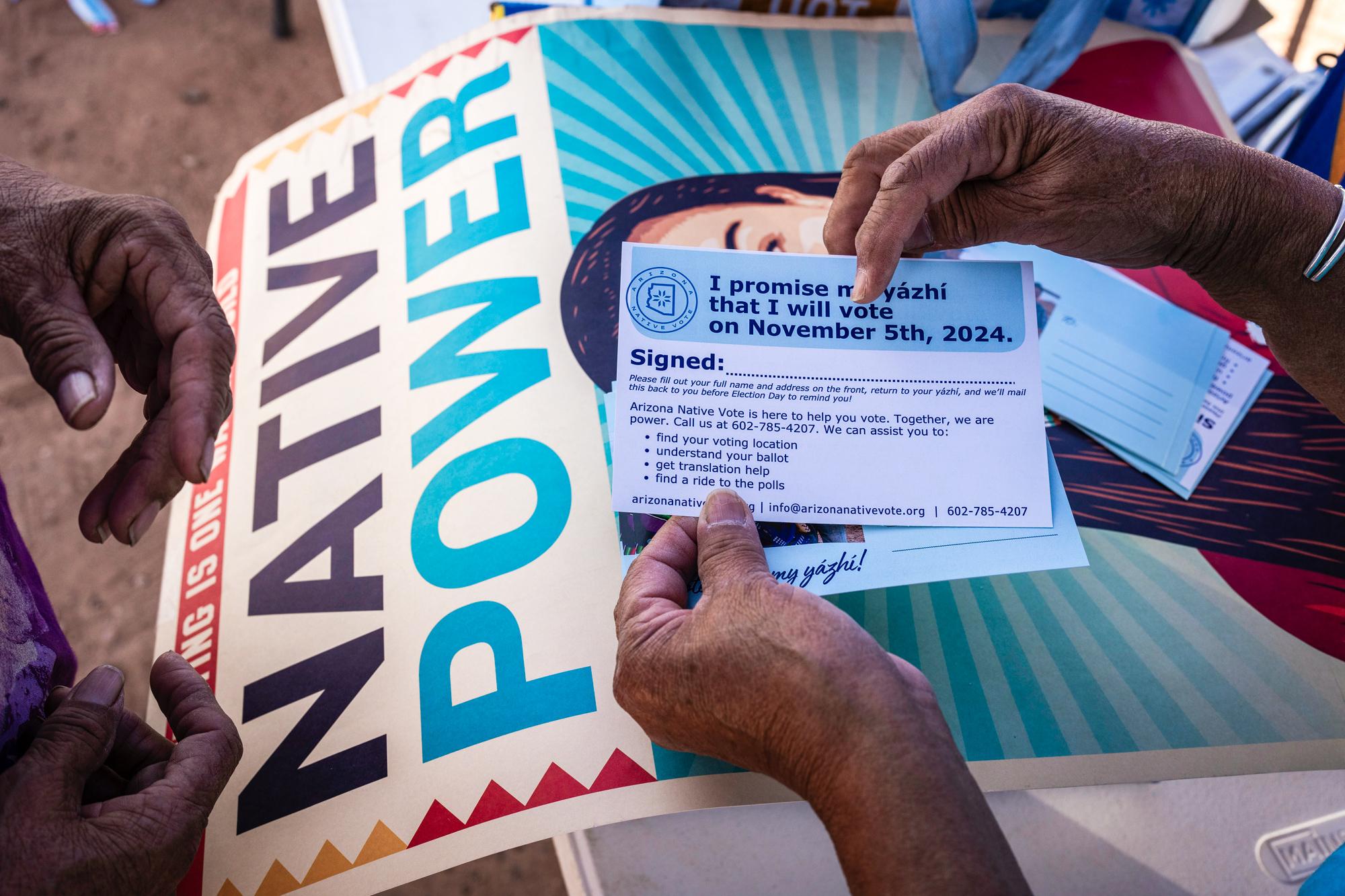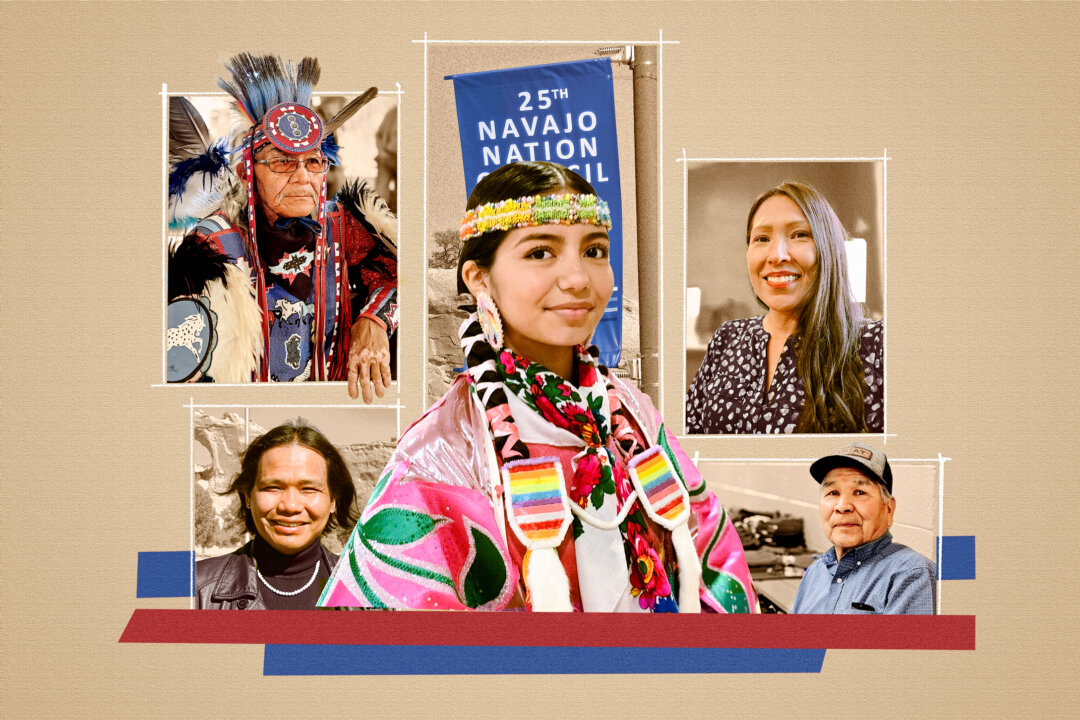WINDOW ROCK, Ariz.—With a population of more than 165,000 people, the Navajo Nation is the largest indigenous reservation in the United States, occupying 16 million acres, about the size of West Virginia.
It is a land of stunning desert beauty, with majestic mountains, sandstone canyons and red-rock formations, and highways that stretch for miles with the rising and setting sun.
The Navajo people keep their native traditions, even as they embrace a modern retail economy and a presidential form of government.
They have many of the same aspirations of education and material success, and they face the same social issues as the rest of the country: poverty, drug abuse, and broken families.
Although not fundamentally partisan, the Navajo tend to vote for Democratic Party candidates because they believe they best serve the community’s interests.
Many also believe that voting in elections and working with the federal government can help tribal communities grow and prosper.
In 2020, there were 67,000 eligible Navajo voters, the vast majority of whom supported Democrat presidential candidate Joe Biden, who won Arizona by just over 10,000 votes.
In the 2024 election, Navajo support for Republican nominee Donald Trump increased, a sign of what some tribal leaders across the country see as a conservative shift in Native American voting patterns.
An Edison Research exit poll showed that the Native American vote was about 65 percent in Trump’s favor nationwide.
However, a Native News Online poll found that support was around 51 percent in the 2024 presidential election.
According to the same poll, Democratic nominee Vice President Kamala Harrisreceived 48 percent of the vote.
Thirty-one percent of participants identified as Democrats, 28 percent as Republicans, and 6 percent as other.

Both presidential candidates campaigned heavily in Arizona, a swing state with a 5.2 percent Native American population.
Alastair Lee Bitsoi, staff writer for the Navajo Nation Office of President Buu Nygren, said there was a noticeable uptick in support for Trump among Navajo voters this year.
He said more Navajo voters felt that Trump would be better for the economy and bread-and-butter issues.
“The pulse I heard on the ground was similar to the American patterns of voting. I saw a lot more—especially young men—who were leaning toward Trump,” Bitsoi told The Epoch Times.
“I live on the New Mexico side of the Navajo Nation. That’s traditionally Republican.
“I feel like it’s all money driven, so a lot of the American influence of how capitalism plays out here in Navajo society,” Bitsoi said.
The Navajo spirit of independence also filtered into the presidential election and support for Trump, he said.
“I feel like the Trump supporters here are mirroring what Trump is echoing out to the masses. There are many ways you can argue it. Some Navajo values are Democrat, some will go Republican.”
In Window Rock, Arizona, the government seat of the Navajo Nation, a large blue campaign sign near a Chevron gas station proclaimed: “Navajos 4 Trump.”
Nearly 67 miles northwest of Window Rock, in Chinle, a large white sign encouraged Navajo voters to “Vote Democratic Not Crazy Republican Trump’s Allies.”
Even though more Navajo voters voiced support for Trump, the differences weren’t as heated or confrontational as the rest of America, said Holly James, Nygren’s communications director.
James said the Navajo commitment to family and community spirit, known as “k’e,” is considered sacred in matters of culture and politics.
Often, the two don’t mix. But when they do, people try to be polite and united in their culture.


During the 2022 midterm elections, James said there was less visible support for the GOP, “but now, that’s evolved. Now, it’s bigger. Why? I don’t know.
“There used to be a Trump sign here—but now, there are whole booths” supporting him, James said. “People wanting to recruit other Navajo to support” Republican candidates.
On Nov. 6, Nygren, a Democrat, issued a statement congratulating Trump on his electoral victory and that he is looking forward to building a “constructive relationship” between the incoming administration and the Navajo Nation.
“He shared a message of collective progress and national unity,” Nygren wrote. “Many Navajo Nation members supported his campaign, and this sentiment was evident as I traveled across the Nation on election night.
“The Navajo Nation faces many challenges that require collaboration and meaningful support from our federal leadership. We believe that by working together we can address these needs and uplift our communities.”
Bitsoi said that meeting basic human needs and tribal community development often requires the ability to work with all sides of the political spectrum.
“I feel like no matter what—at the basic core of the government—under President Nygren—whether it’s blue or red, at the end of the day, the Navajo people need basic infrastructure—water, power, electricity, and homes,” he said.
“Whether the Republicans can get us that or the Democrats can get us that, it’s at the core of the Navajo Nation and society at this point.”
Limited employment opportunities accentuate the socio-economic conditions of the Navajo Nation; the current unemployment rate ranges between 48.5 and 61 percent, and the average household income is $33,578, well below the federal poverty guidelines.
“These factors indicate a need for implementation of agricultural programs, policies, regulations, and conservation programs to revitalize our rural economy for self-sufficiency,” according to the Navajo Nation website.
In January, the Navajo Nation received nearly $89 million through the expanded State Small Business Credit Initiative as part of the post-pandemic American Rescue Plan Act.
The nation will use the funding to implement programs to support Navajo small businesses and tribal enterprises.
“Like many in the United States, citizens of Tribal Nations are rebuilding their communities, jobs, and infrastructure after the devastating impact of the COVID-19 pandemic,” according to the U.S. government website performance.gov.

“In 2021, Tribal Nations saw historic federal investments, including direct investments and grants,” it said, listing new legislation as the source, including including the Coronavirus Aid, Relief, and Economic Security Act, the American Rescue Plan Act , and the Infrastructure Investment and Jobs Act.
“These bills alone total about $53 billion, an enormous increase in funds from previous years.”
The Navajo Nation’s vision statement emphasizes the significance of land, people, water, and agricultural resources, citing preservation and conservation as primary objectives.
Nationwide Trend
Compared with past elections, turnout among the Hopi (population 12,600), located in northeastern Arizona, was higher in the 2024 presidential election.
“This year’s election saw Hopi voters showing up at the polls in record numbers, a testament to rising engagement and a heightened sense of urgency among Indigenous populations,” the Hopi Times reported.
“The issues on the ballot—education, health care, environmental policy, and Indigenous sovereignty—have deep personal impacts for Hopi people and motivated many to make their voices heard,” the newspaper reported.
The higher turnout is part of a trend that is seen across Native American communities.

The number of Hopi voters may have risen by as much as 15 percent, which shows both the expansion of voter outreach efforts and a deep commitment to fighting for Indigenous rights and community goals through the ballot box, the Hopi Times noted.
The Navajo experience with American settlers, like other Native American tribes, has been long and often tragic.
U.S. Army Col. Kit Carson’s scorched earth policy saw Navajo villages burned and livestock killed, and many people starved to death.

In 1864, U.S. soldiers took 8,000 Navajo men, women, and children and sent them 300 miles to Fort Sumner, New Mexico.
Among the Navajo, it is known as “The Long Walk.” Many died during the trek or in prison.
In 1868, Navajos agreed to return to their land in the Four Corners area where Arizona, New Mexico, Utah, and Colorado meet.
The federal government recognizes 574 tribes and 325 reservations in the United States. The Native American population is currently between 4 million and 7 million people.
Tribal communities are sovereign by treaty and are allowed to vote in federal elections under the Indian Citizenship Act of 1924, known as the Snyder Act.
James said the COVID-19 pandemic seems to have increased support for the GOP among the Navajo, though the numbers are difficult to quantify.
“Here, in Navajo, we have a lot of variables to weigh,” she said. “We are very much engulfed in our language—who we are as Navajo, our culture—from the smallest grain of sand to the cloud in the sky.
“So, sometimes people have taken that it’s popular to be a Republican without educating themselves about what that means.”
James said she thinks some Navajo voters cast their ballots out of a need for “instant gratification—help me in my current state.”
“My take is that the population that maneuvered from Independent to Democrat to Republican is that good old hard cash—not the greediness of it, but finally I can get relief, cheaper gas, a cheaper home, cheaper this, cheaper that. And this guy is going to get it for me.”
The rough terrain and dirt roads that still characterize much of Navajo land made it difficult for many voters to reach a voting center on Election Day.
Many people drove 30 miles to cast their ballots, James said.
The machines that counted votes had problems, and poll workers turned away voters without giving them a temporary ballot to vote elsewhere.
“There were elders in wheelchairs and [using] canes who could not walk. A lot of these facilities were not ADA [Americans With Disabilities] compliant,” James said.
“We were taking our neighbors—we were taking everyone. We were all going to vote. They didn’t have a vehicle, or they did, and they only used it to come to town for monthly grocery shopping. It’s used as needed.”

“That’s how we do it,” James added. “That’s the everyday. Grandma needs wood. We all rally in that one vehicle to get Grandma what she needs and come back. All of us pitch in in some way.”
James said it took a court order to get an extension to cast ballots and give more temporary ballots.
“We are so behind the times, and so red-taped with funds that come from the government under the treaty,” she said.
Keeping Tradition Alive
Each year, Native Americans celebrate their cultural heritage with intertribal gatherings called powwows.
From Nov. 15–17, the Red Paint Powwow at Western New Mexico University in Silver City drew members from around 40 tribes who took part in dance, singing, and drum competitions.
Participants donned traditional ceremonial attire, showcasing the cultural legacy of each distinct tribe in the spirit of unity.
“Any Cherokee?” Master of Ceremonies Gabriel Ayala, a member of the Yaqui people of southern Arizona and a classical musician, asked the large gathering. “What about Navajos? Any Lakota out there? Stand up. Be proud!”
“It’s going to be a beautiful day, relatives.”
Dr. Bill Bradford, whose tribal name is Tooahyasa, co-organized the Red Paint Powwow and explained that the gathering was purely a celebration of indigenous culture.
Bradford, the attorney general of the Chiricahua Apache Nation, was the director of Indian Energy at the U.S. Department of Energy under Trump during his first term.
“We have our politics, but our politics are solely oriented towards our people,” Bradford said. “It’s nonpartisan in the sense that anyone who wants to join us is a Democrat, Republican, or Independent.”
“I do know there are shy Trump voters. A lot of people wouldn’t tell you. And I also know that, at least from my perspective, in this area, which is not a wealthy area, kitchen table issues matter to a lot of people.”
Bradford said that when tribal communities engage in federal politics, it’s to help the people and community in matters of cultural survival, land reclamation, and community development.

He said that politics is about division, so it is separate from native culture.
“There are ties that bind us more than other social groups. We depend on each other more and always have. So we try to prevent schisms,” Bradford told The Epoch Times.
“I think we also work hard not to make anybody feel that they have to think or speak a certain way—at least, not in our culture.”
But ultimately, it’s about preserving tribal sovereignty and looking ahead to the future, he said.
Native Voices Rising
There is a saying, Bradford said, that native people are like all other people—“only more so.”
They have the same issues and dreams of better lives for their children, but the idea of family is bound to spirituality and traditional beliefs.
“If we lose either—or both—then we’re not really who we are or were anymore,” he said.
“I don’t think you can reach cultural or sovereignty issues without engaging politically. Unfortunately, that runs counter to what most of us would prefer.
“You can economically achieve economic growth and do social justice. If you can figure that out, that’s the key. We want to work with this administration, as we’d want to work with any administration.”
Julius Claw is a member of the Navajo Nation from Utah who sold handmade blankets at the powwow.
Claw, a disabled veteran who is a Democrat, thought Harris would win the election.
“I thought it was going to be the other way around. It didn’t work out like that,” he said.
“A lot of it has to deal with the economy—gas prices, and prices [in general]. They think it has something to do with the Democrats. I think that’s why they voted for Trump. I didn’t vote for Trump. I had my reasons, you know?”
Bitsoi said that other influences shifted more Navajo to vote for Trump, and in many ways, Navajo politics reflect the wider non-native society.

Christian Navajo voters saw issues such as abortion, family values, and gun ownership rights as key drivers, as well as inflation and the ability to make ends meet.
“A lot of the Republican values still infiltrate through the churches, so that’s another variable,” Bitsoi said. “It could be a lot of things.”
“I think it speaks volumes that people are voting because of what they’re lacking,” James said.
“I do believe we’re at a point where we’re educating ourselves—where both the youths and the old are really participating in the outcome.”
“I think the [next] four years is really going to push people on how democracy works—how politics works. Whatever the hype or the attention is now, I’m grateful for it. We have to educate ourselves and our families.”
The past three presidential elections have shown that the Native American vote is becoming increasingly important in federal elections, especially in the swing states, Bitsoi said.
“We are a force to be recognized—and reckoned with,” he said.






